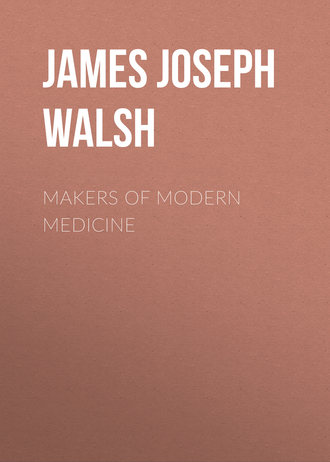 полная версия
полная версияПолная версия
Makers of Modern Medicine
She was herself a woman of well-developed intellect, and her association with her father and husband made her well acquainted with the anatomy and physiology of the day. She realized that what had occurred was quite out of the ordinary. Accordingly, she called the attention of her husband to the phenomena, and is even said to have suggested their possible connection with the presence and action of the electric apparatus. Husband and wife then together, by means of a series of observations, determined that whenever the apparatus was not in use the phenomenon of the conclusive movements of the frog's legs did not take place, notwithstanding irritation by the scalpel. Whenever the electric apparatus was working, however, then the phenomenon in question always took place. According to either form of the story it is clear that Madame Galvani had an important part in the discovery, and Galvani himself, far from making little of what she had accomplished, was always glad to attribute his discovery, or at least the suggestive hint that led up to it, to his wife.
After these first discoveries on the influence of artificial electricity, nothing seemed more interesting than to investigate whether ordinary atmospheric electricity as manifested in lightning would produce the same effects on muscular movements. In this matter Galvani showed much courage as an inventive genius. He dared to place an atmospheric conductor on the highest point of his house and to this conductor he attached a wire, which ran down to his laboratory. During a storm he suspended on this metallic circuit by means of their sciatic nerves frogs' legs and the legs of other animals prepared for the purpose. To the feet of the animals he attached another wire sufficiently long to reach down to the bottom of a well, thus completing a current to the ground.
All the phenomena took place exactly as if with artificial electricity. Whenever lightning flashed from the clouds the limbs of the animals experimented with underwent violent contractions, which were noticeable before the noise of the thunder, and were, so to say, the signal for it. These contractions took place, although there were no conductors from the muscles, and although the nerve conductors were not isolated. The muscular contractions were greater in proportion than the intensity of the lightning and the proximity of the storm. The phenomena were manifest whether the animal was in the open air or if, for greater convenience, it was enclosed in a room, or even in a vessel. The muscular contractions could even be noticed despite the fact that the nerves were separated somewhat from their conductor, especially whenever the lightning was violent. The sparks would leap over a small gap almost as in the case of artificial electricity, the muscular contraction of the animal being proportioned to the energy and the nearness of the sparks.
It is almost needless to say, these experiments upon the frog were not accomplished in a few days or a few weeks. Galvani had his duties as Professor of Anatomy to attend to, besides the obligations imposed upon him as a busy practitioner of medicine and surgery. At that time it was not nearly so much the custom as it is at present, to use frogs for experiments, with the idea that conclusions might be obtained of value for the biological sciences generally, and especially for medicine. There has always been an undercurrent of feeling that such experiments are more or less a beating of the air. Galvani found opposition not only to his views with regard to animal electricity as enunciated after experimental demonstration, but also met with no little ridicule because of the supposed waste of time at occupations that could not be expected to lead to any practical results. It was the custom among scientific men to laugh somewhat scornfully at his patient persistence in studying out every detail of electrical action on the frog, and one of the supposedly prominent scientists of the time even dubbed him the frog dancing master. This did not, however, deter Galvani from his work, though some of the bitter things must have proved cutting enough, and might have discouraged a smaller man, less confident of the scientific value of the work that he was doing.
There were even phases of physical science quite apart from physiology or animal electricity, which he was able to illustrate by his experiments. He called special attention, for instance, to the fact that the lightning does not excite a single contraction of the muscle as is the case with a spark of artificial electricity, but that there are a series of muscular contractions succeeding one another rapidly in diminishing energy and somewhat corresponding to the reiterated reports of thunder. This was Galvani's expression for the dying away of the electrical influence upon the muscle. He had thus evidently reached a hint of the pendulum-like swing with which electrical equilibrium is restored after its violent disturbance immediately following the lightning stroke. He noted, moreover, that for the production of muscular contractions the absolute appearance of lightning was not indispensable. Muscular twitchings were noted whenever the heavens were overclouded by a storm, or whenever clouds charged with electricity were passed above the conductor.
These experiments were made upon living frogs, as well as upon the separated legs, and in both cases the results obtained were very similar to those observed on the employment of some form of artificial electricity. In some of these observations, Galvani was anticipating ideas that became current truth in electrical science only many years after his time. In his observations upon the effects of lightning, he was forestalling Franklin's works to a certain extent. Both of these great scientists, however, had been anticipated by a clergyman in Austria; whose work attracted very little attention, however, because he was not in touch with the scientific bodies of the day. The demonstration of the identity of ordinary terrestrial artificial electricity and the lightning was in the air, as it were, and many workers, as is usually the case with any great discovery, came very close to it, and deserve at least a portion of the credit for it.
It is almost needless to say, many of these experiments with lightning thus conducted by Galvani were not without an element of serious personal danger. Not long after this time a Russian savant, Richman by name, while repeating Franklin's experiments with the kite, was struck dead by the charge received from his apparatus. Galvani, however, devoted himself only in passing to the physical problems involved, and kept always in view the physiological aspects of the problem of animal electricity; and, accordingly, made a series of most interesting observations on the ray fish or torpedo, as it is sometimes called, the fish which gives electrical shocks. His idea was to demonstrate that the shocks felt when this animal is touched are really due to sparks of electricity similar to those which can be obtained by artificial means. This had never been determined, and Galvani succeeded in showing the presence of sparks exactly as if the animal were one of the apparatuses by which the sparks of frictional electricity are developed. At this time this seemed surprising enough. Galvani also endeavored to demonstrate that the electricity in the electric torpedo differed only in degree, but not in quality, from certain electric manifestations that he had noted in the bodies of other animals, especially the frog. His idea always was to show the existence of a natural animal electricity, by means of which some of the complex mechanism of life was accomplished. He seems to have had some notion of the theory that has been suggested often enough since, and is not yet entirely disproved, that there is some very close relationship between nerve impulses and the electric current. In this, of course, he was far ahead of his time, and utterly unable to make absolute demonstration, because of the lack of proper apparatus.
The most interesting quality of Galvani's scientific career is the thoroughly experimental character of all his researches into natural phenomena. Few men have known so well how to vary their experiments so as to bring out new details of scientific knowledge. His experimental skill was of the highest order, and it is to this that we owe the development in his hands of the nascent science of electricity to a point where it became easy to continue its natural evolution. Galvani's work furnished the necessary stimulus to Volta, and then the real foundation of modern electricity was laid.
Almost more interesting than Galvani the scientist, however, is Galvani the man. As one of his biographers said of him, he joined to the most eminent intellectual genius a group of very precious qualities of the heart. Utterly unselfish in his relationship to others, he was known to be extremely sympathetic and had a large number of friends. His friends, too, he bound to him by even more than the proverbial hoops of steel, so that when they passed out of life they left him unconsolable. While it was very hard to get him to take part in social functions at which numbers of people were gathered, he was by no means a recluse, and liked to be in the company of a few friends. He seemed to care very little for the renown that his discoveries gave him, and refused, as far as possible, to be made the object of public congratulations and testimonials.
His relations with his patients–for during all of his long career he continued to practise, especially surgery and obstetrics–were of the friendliest character. While his distinction as a professor at the university gave him many opportunities for practice among the rich, he was always ready and willing to help the poor, and, indeed, seemed to feel more at home among poor patients than in the society of the wealthy and noble. Even towards the end of his life, when the loss of many friends, and especially his wife, made him retire within himself much more than before, he continued to exercise his professional skill for the benefit of the poor, though he often refused to take cases that might have proved sources of considerable gain to him. Early in life, when he was very busy between his professional work and his practice, he remarked more than once, on refusing to take the cases of wealthy patients, that they had the money with which to obtain other physicians, while the poor did not, and he would prefer to keep some time for his services for them.
Toward the end of his life Galvani was not a little perturbed by the course of events around him and by the sweeping away of faith in old beliefs, consequent upon the French Revolution and the philosophic movement that had led up to it. Seeing around him, too, the abuses to which this supposed liberty and assertion of the rights of man led, it used to be a favorite expression of Galvani that "A little philosophy led men away from God, but a good deal of it led them back to Him again." Especially did he consider this true with regard to younger men, whose lack of wisdom in the difficult phases of life made them think their philosophy of things was complete, until sad experience had taught them the necessity for lifting men's minds above any mere religion of humanity, any mere stoic resignation to the inevitable, if what was best in them was to be brought out.
A very interesting phase of the Italian university life of that time is revealed in two important incidents of Galvani's university career. One of his professors, one, by the way, for whom he seems to have had a great deal of respect, and to whose lectures he devoted much attention, was Laura Caterina Maria Bassi, the distinguished woman professor of philosophy at the University of Bologna, about the middle of the eighteenth century. It is doubtless to her teaching that Galvani owes some of his thoroughgoing conservatism in philosophic speculation, a conservatism that was of great service to him later on in life, in the midst of the ultra-radical principles which became fashionable just before and during the French Revolution. Madame Bassi seems to have had her influence on him for good not only during his student career, but also later in life, for she was the wife of a prominent physician in Bologna, and Galvani was often in social contact with her during his years of connection with the university.
As might, perhaps, be expected, seeing that his own happy domestic life showed him that an educated woman might be the centre of intellectual influence, Galvani seems to have had no spirit of opposition to even the highest education for women. This is very well illustrated by the first formal lecture in his course on anatomy at the university, which had for its subject the models for the teaching of anatomy that had been made by Madame Manzolini. In the early part of the eighteenth century Madame Manzolini had been the professor of anatomy at the University of Bologna, and in order to make the teaching of this difficult subject easier and more definite she modelled with great care and delicate attention to every detail, so that they imitated actual dissections of the human body very closely, a set of wax figures which replaced the human body for demonstration purposes at least at the beginning of the anatomical course.
Galvani, in taking up the work of lecturer on anatomy, appreciated how much such a set of models would help in making the introduction to anatomical study easy, yet at the same time without detracting from its exactness, and, accordingly, introduced his students to Madame Manzolini's set of models in his very first lecture. At the time there were those connected with the teaching of anatomy who considered the use of these models as rather an effeminate proceeding. Galvani's lack of prejudice in the matter shows the readiness of the man to accept the best wherever he found it without regard to persons or feelings.
He was one of the most popular professors that the University of Bologna has ever had. He was not in the ordinary sense of the word an orator, but he was a born teacher. The source of the enthusiasm which he aroused in his hearers was undoubtedly his own love for teaching and the power it gave him to express even intricate problems in simple, straightforward language. More than any of his predecessors he understood that experiments and demonstrations must be the real groundwork of the teaching of science. Accordingly, very few of his lectures were given without the aid of these material helps to attract attention. Besides he was known to be one who delighted to answer questions and was perfectly frank about the limitations of his knowledge whenever there was no real answer to be given to a question that had been proposed. Though an original discoverer of the first rank, he was extremely modest, particularly when talking about the details of his discoveries, or subjects relating to them.
The most striking proof of the thorough conscientiousness with which he faced the duties of life is to be found in his conduct after the establishment of the so-called Cis-Alpine Republic in Italy. This was a government established merely by force of arms without the consent of the people and a plain usurpation of the rights of the previous government. He considered himself bound in duty to the authority under which he had lived all his previous life and to which he had sworn fealty. When the University of Bologna was reorganized under the new government the first requirement of all those who were made professors was that they should take the oath of allegiance to the new government. This he refused to do. His motives can be readily understood, and though practically all the other professors of the university had taken the oath he did not consider that this freed him from his conscientious obligations in the matter.
Accordingly, he was dropped from the roll of professors and deprived of the never very large salary which he had obtained from this chair. On this sum he had practically depended for his existence and he soon began to suffer from want. While he had been a successful practitioner of medicine, especially of surgery, he had always been very liberal and had spent large sums of money in demonstrations for his lectures and personal experimentation and in materials for the museums of the university. He began to suffer from actual want and friends had to come to his assistance. He refused, however, to give up his scruples in the matter and accept the professorship which was still open for him. Finally, at the end of two years, influence was brought to bear on the new government and Galvani was allowed to accept his chair in the university without taking the oath of allegiance. This tribute came too late, however, and within a short time after his restoration to his professorship he died.
That his action in this matter was very properly appreciated by his contemporaries, and that the moral influence of his example was not lost, can be realized from the expressions used by Alibert, the Secretary-general of the Medical Society of Emulation, in the historical address on Galvani which he delivered before that society in 1801:
"Galvani constantly refused to take the civil oath demanded by the decrees of the Cis-Alpine Republic. Who can blame him for having followed the voice of his conscience, that sacred, interior voice, which alone prescribes the duties of man and which has preceded all human laws? Who could not praise him for having sacrificed with such exemplary resignation all the emoluments of his professorship rather than violate the solemn engagements made under religious sanction?"
In the same panegyric there is a very curiously interesting passage with regard to Galvani's habit of frequently closing his lectures by calling attention to the complexity yet the purposefulness of natural things and the inevitable conclusion that they must have been created with a definite purpose by a Supreme Being possessed of intelligence. At the time that Alibert wrote his memoir it was the fashion to consider, at least in France, that Christianity was a thing of the past, and that while theism might remain, that would be all that could be expected to survive the crumbling effect of the emancipation of man.
He says: "We have seen already what was Galvani's zeal and his love for the religion which he professed. We may add that in his public demonstration he never finished his lectures without exhorting his pupils to a renewal of their faith by leading them always back to the idea of the eternal Providence which develops, preserves and causes life to flow among so many different kinds of things. I write now," he continues, "in the age of reason, of tolerance and of light. Must I then defend Galvani in the eyes of posterity for one of the most beautiful sentiments that can spring from the nature of man? No, and they are but little initiated in the saner mechanism of philosophy who refused to recognize the truths established on evidence so strong and so authentic. Breves haustus in philosophiâ ad atheismum ducunt, longiores autem reducunt ad deum, small draughts of philosophy lead to atheism, but longer draughts bring one back to God"–(which may perhaps be better translated by Pope's well-known lines, "A little learning (in philosophy) is a dangerous thing; drink deep or touch not the Pierian spring").
Galvani has been honored by his fellow-citizens of Bologna as one of their greatest townsmen and by the university as one of her worthiest sons. In 1804 a medal was struck in his honor, on the reverse of which, surrounding a figure of the genius of science, were the two legends: "Mors mihi vita" "Death is life or me," and "Spiritus intus alit," "The spirit works within," which were favorite expressions of the great scientist while living and are lively symbols of the spirit which animated him. In 1814 a monument was erected to him in the courtyard of the University of Bologna. It is surmounted by his bust, made by the most distinguished Bolognian sculptor of the time, De Maria. On the pedestal there are two figures in bas-relief executed by the same sculptor, which represent religion and philosophy, the inspiring geniuses of Galvani's life.
Before he died, he asked, as had Dante, whose work was his favorite reading, to be buried in the humble habit of a member of the Third Order of St. Francis. He is said to have valued his fellowship with the sons of the "poor little man of Assisi" more than the many honorary fellowships of various kinds which had been conferred upon him by the scientific societies all over Europe.
LAENNEC, MARTYR TO SCIENCE
The knowledge which a man can use is the only real knowledge, the only knowledge which has life and growth in it and converts itself into practical power. The rest hangs like dust about the brain, or dries like rain-drops off the stones.
--Froude.On August 13, 1826, there died at Quimper in Brittany at the early age of forty-five, one of the greatest physicians of all time. His name, René Theodore Laennec, was destined to be forever associated with one of the most fruitful advances in medicine that has ever been made, and one which practically introduced the modern era of scientific diagnosis. At the present time the most interesting phase of medical development is concerned with the early recognition and the prevention of tuberculosis. To Laennec more than to any other is due all the data which enable the physician of the twentieth century to make the diagnosis of tuberculosis with assurance, and to treat it with more confidence than before, and so prevent its spread as far as that is possible.
The history of pulmonary consumption in its most modern phase is centred around the names of three men, Laennec, Villemin, and Koch. To Laennec will forever belong the honor of having fixed definitely the clinical picture of the disease, and of having separated it by means of auscultation and his pathological studies from all similar affections of the lungs. Villemin showed that it was an infectious disease, absolutely specific in character, and capable of transmission by inoculation from man to the animal. To Koch the world owes the knowledge of the exact cause of the disease and consequently of the practical method for preventing its spread. The isolation of the bacillus of tuberculosis is the great triumph of the end of the nineteenth century, as the separation of the disease from all others by Laennec was the triumph of the beginning of that century. There is still room for a fourth name in the list, that of the man who will discover a specific remedy for the disease. It is to be hoped that his coming will not be long delayed.
The estimation in which Laennec was held by the most distinguished among his contemporaries, may be very well appreciated from the opinions expressed with regard to him and his work by the best-known Irish and English clinical observers of the period. Dr. William Stokes, who was himself, as we shall see, one of the most important contributors to our clinical knowledge of diseases of the heart and lungs in the nineteenth century, said with regard to the great French clinician whom he considered his master:
"Time has shown that the introduction of auscultation and its subsidiary physical signs has been one of the greatest boons ever conferred by the genius of man on the world.
"A new era in medicine has been marked by a new science, depending on the immutable laws of physical phenomena, and, like the discoveries founded on such a basis, simple in its application and easily understood–a gift of science to a favored son; one by which the ear is converted into the eye, the hidden recesses of visceral disease open to view; a new guide to the treatment, and a new help to the ready detection, prevention and cure of the most widely spread diseases which affect mankind."
Dr. Addison, who is best known by the disease which since his original description has been called by his name, was no less enthusiastic in praise of Laennec's work. He said:
"Were I to affirm that Laennec contributed more toward the advancement of the medical art than any other single individual, either of ancient or of modern times, I should probably be advancing a proposition which, in the estimation of many, is neither extravagant nor unjust. His work, De l'Auscultation Mediate, will ever remain a monument of genius, industry, modesty and truth. It is a work in perusing which every succeeding page only tends to increase our admiration of the man, to captivate our attention, and to command our confidence. We are led insensibly to the bedside of his patients; we are startled by the originality of his system; we can hardly persuade ourselves that any means so simple can accomplish so much, can overcome and reduce to order the chaotic confusion of thoracic pathology; and hesitate not in the end to acknowledge our unqualified wonder at the triumphant confirmation of all he professed to accomplish."











